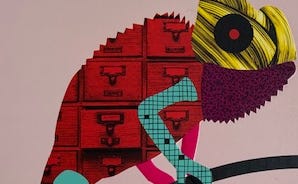'The Cabinet' by Un-Su Kim
'That there is no moral of the story—that's the moral of the story.'—Review #208

I put Un-Su Kim’s weird and wild novel ‘The Cabinet’ on my list after reading about it in The New York Review of Books. Shortly thereafter, if I remember correctly, I passed the book on a table in the Strand, and when I saw its unusual and beautiful cover design, I was like:

I mean, look at it. It’s great!
Here’s the cover:
Despite what the cover shows, there is neither a cat nor a chameleon in this book. Instead, there is a woman who has a tiny lizard living in her mouth where her tongue should be and there’s a man who wants to transform into a cat so a different woman will return his unrequited love. These are two of the bizarre characters readers encounter as the protagonist, a young office worker named Mr. Kong, reveals the contents of the mysterious Cabinet 13, a standard filing cabinet that contains paperwork on people called ‘Symptomers.’ Symptomers can do all sorts of strange things, like drink gasoline, eat glass or steel, sleep for a really long time, survive volcanic eruptions or have a ginkgo tree growing out of a finger. Mr. Kong works for an agency tasked with studying, keeping tabs on and helping the Symptomers. In the first part of the book, Mr. Kong describes several of them in a way that evokes Marco Polo’s descriptions of fantastic places to Kublai Khan in Italo Calvino’s ‘Invisible Cities.’ Mr. Kong’s boss, Professor Kwon, believes the Symptomers are the next stage in human evolution. But sinister forces want to exploit them and go to intense ends to do so. I won’t give it away, but the climax drops the Calvino vibes and had me like:
‘The Cabinet’ won the Munhakdongne Novel Prize, a prestigious Korean literary award, in 2006, and there was a lot I enjoyed about it (bizarre books are up my alley). It opens with a warning that ‘the information contained in this novel has been manufactured, modified, or distorted in some way, and should not be used as evidence in any argument, be it in a respected academic journal or a heated bar fight.’ But I ignored this guidance yesterday in a conversation with friends (not a fight) when I described a short scene from the book that stuck with me. We were discussing the various problems in the world today when I told them about a character who says that since the invention of the electric light, there has been no true darkness in the world, limiting people’s ability to sleep well. And because everyone is not getting enough sleep, we’re all feeling more anxiety, which also interferes with sleep and causes more anxiety—a vicious circle. When you think about how we all live with lights constantly shining in our face, either from the street outside, or a clock radio (do people still have these?), or the TV or computer screens, or from the phones next to us on the nightstand, we agreed:
I also enjoyed how the book suggests that we respect and protect the lives of people who are different from us, a very important point today. And I liked how it critiques monotonous office culture—Mr. Kong’s boredom at work invites calamity. But this book isn’t for every reader, and even though I liked it, I struggled at parts to maintain focus and attention on the pages and plot. I often found myself nodding off, or putting the book down to look at my phone. But that could be due more to the fact that my last two weeks have been a struggle with anxiety and sleep deprivation. So don’t let me discourage you. If you’re up for a quirky and intense book, check out ‘The Cabinet.’
How it begins:
It is called Cabinet 13. But there is no particular reason for the number 13. It only means it’s the thirteenth cabinet from the left. This would probably be a better introduction if it had a fancier name. But then again, what would you expect from a cabinet?
There is no need to imagine anything grand. If by some chance you intend on reading this book to the end, it would be best if you rid yourself now of any fanciful or romantic expectations, because if you have such expectations, you will only see that or less.
No, this is an exceedingly ordinary cabinet. The kind that was in vogue in government office buildings during the 80s and 90s. It is an unsightly, dilapidated cabinet, mind you. The kind perfect for stashing away smelly gym clothes, lonely tennis shoes, deflated soccer balls, and expired documents. The sort of cabinet that requires no imagination to think of. Yes, that thing you just thought of now, despite saying to yourself, “No, you can’t mean this.” Yes, that. That is precisely the kind of cabinet we’re talking about.
My rating:

‘The Cabinet’ (‘Kaebinit’) by Un-Su Kim was originally published by Munhakdongne in 2006. Translated from the Korean by Sean Lin Gilbert and published by Angry Robot in 2021. 301 pages. $14.87 at Bookshop.org.
What’s next:
In two weeks, Books on GIF will turn:

We’re celebrating our 7th anniversary by highlighting our 7 favorite novels from the past 7 years. Look for it on May 7!
Before you go:
ICYMI: Review #207
Read this: I wrote about Lindsay Lohan’s Christmas rom-com ‘Falling for Christmas’ for the newsletter Meet Cute Missives. Check it out:
If you enjoyed this review:
Thanks for reading, and thanks especially to Donna for editing this newsletter!
Until next time,
MPV












I love crazy books too! This sounds so up my alley! Thanks for sharing.
I also like crazy, so I'm up for reading this.
I hope the anxiety has lessened, that the sleep has increased.